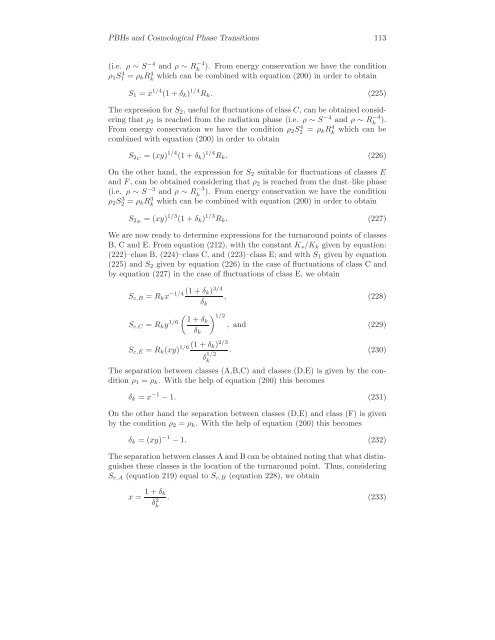Primordial Black Holes and Cosmological Phase Transitions Report ...
Primordial Black Holes and Cosmological Phase Transitions Report ...
Primordial Black Holes and Cosmological Phase Transitions Report ...
Create successful ePaper yourself
Turn your PDF publications into a flip-book with our unique Google optimized e-Paper software.
PBHs <strong>and</strong> <strong>Cosmological</strong> <strong>Phase</strong> <strong>Transitions</strong> 113<br />
(i.e. ρ ∼ S−4 <strong>and</strong> ρ ∼ R −4<br />
k ). From energy conservation we have the condition<br />
ρ1S4 1 = ρkR4 k which can be combined with equation (200) in order to obtain<br />
S1 = x 1/4 (1 + δk) 1/4 Rk. (225)<br />
The expression for S2, useful for fluctuations of class C, can be obtained considering<br />
that ρ2 is reached from the radiation phase (i.e. ρ ∼ S−4 <strong>and</strong> ρ ∼ R −4<br />
k ).<br />
From energy conservation we have the condition ρ2S4 2 = ρkR4 k which can be<br />
combined with equation (200) in order to obtain<br />
S2C =(xy) 1/4 (1 + δk) 1/4 Rk. (226)<br />
On the other h<strong>and</strong>, the expression for S2 suitable for fluctuations of classes E<br />
<strong>and</strong> F , can be obtained considering that ρ2 is reached from the dust–like phase<br />
(i.e. ρ ∼ S−3 <strong>and</strong> ρ ∼ R −3<br />
k ). From energy conservation we have the condition<br />
ρ2S3 2 = ρkR3 k which can be combined with equation (200) in order to obtain<br />
S2E =(xy) 1/3 (1 + δk) 1/3 Rk. (227)<br />
We are now ready to determine expressions for the turnaround points of classes<br />
B, C <strong>and</strong> E. From equation (212), with the constant Ks/Kk given by equation:<br />
(222)–class B, (224)–class C, <strong>and</strong> (223)–class E; <strong>and</strong> with S1 given by equation<br />
(225) <strong>and</strong> S2 given by equation (226) in the case of fluctuations of class C <strong>and</strong><br />
by equation (227) in the case of fluctuations of class E, we obtain<br />
3/4<br />
−1/4 (1 + δk)<br />
Sc,B = Rkx , (228)<br />
δk<br />
δk<br />
Sc,C = Rky 1/6<br />
1/2 1+δk<br />
, <strong>and</strong> (229)<br />
2/3<br />
1/6 (1 + δk)<br />
Sc,E = Rk(xy) . (230)<br />
δ 1/2<br />
k<br />
The separation between classes (A,B,C) <strong>and</strong> classes (D,E) is given by the condition<br />
ρ1 = ρk. With the help of equation (200) this becomes<br />
δk = x −1 − 1. (231)<br />
On the other h<strong>and</strong> the separation between classes (D,E) <strong>and</strong> class (F) is given<br />
by the condition ρ2 = ρk. With the help of equation (200) this becomes<br />
δk =(xy) −1 − 1. (232)<br />
The separation between classes A <strong>and</strong> B can be obtained noting that what distinguishes<br />
these classes is the location of the turnaround point. Thus, considering<br />
Sc,A (equation 219) equal to Sc,B (equation 228), we obtain<br />
x = 1+δk<br />
δ2 . (233)<br />
k
















